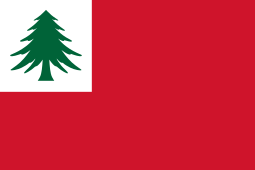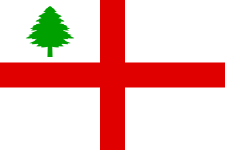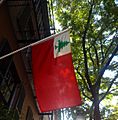Flag of New England facts for kids
New England does not have one official flag. However, many flags have been used throughout history to represent this region. These flags often feature a simple colored background, usually red, with a pine tree in the canton. The canton is the top left corner of a flag. The eastern white pine is a very important symbol for New England. It appears on many flags from the area.
Contents
Flags in New England's Early Days
Most early New England flags were based on the red or blue flags of the Royal Navy. These flags had the Cross of St. George in their canton. This cross is a red cross on a white background. It was a symbol of England.
The flags were used in the Jamestown and Plymouth settlements. However, some early settlers in New England, called Puritans, did not like having a Christian cross on their flag. A leader named Roger Williams led these objections.
For a while, they flew a red flag with a plain white canton, meaning no cross. This new flag first appeared in 1634 in Salem. Some people thought this was an act of rebellion against England. Even so, flags without the cross became popular in New England. Local militia groups even designed their own unique flags.
In 1665, English officials said that all ships and militias should fly "the true colours of England." This was so everyone would know they were loyal to the king. But some flags without the cross were still used as late as 1680.
Adding the Pine Tree Symbol
New Englanders kept looking for ways to show their unique identity. In 1684, the town of Newbury, Massachusetts changed its flag to green. It still had the Cross of St. George.
Later, a pine tree was added to some flags. This happened during the time of King James II. The idea for the pine tree might have come from the pine-tree shilling. This coin was made in Massachusetts and featured a pine tree.
In 1707, a rule was made that all merchant ships must fly the red ensign with the British Union Flag in the canton. To make sure people followed this rule, a picture of the flag was printed in the Boston News-Letter. This was the first picture ever printed in an American newspaper.
The Flag at Bunker Hill
There is some debate about which flag was flown at the Battle of Bunker Hill in 1775. This battle was one of the first in the American Revolutionary War. An officer from the Royal Marines said that the American rebels did not use any flags.
However, John Trumbull, a famous painter of the war, showed a red flag with a pine tree in his 1786 painting. This painting was called The Death of General Warren at the Battle of Bunker's Hill, June 17, 1775. Later, he painted another version for the general's family. In this version, the flag was blue.
Another flag often linked to the battle is blue with a white canton. This canton has the Cross of St. George with a tree in its top left corner. The blue color might have been a mistake. It could have happened because of an error in a wood engraving. This error might have confused painters.
Despite the confusion, the blue flag has become a symbol of the Battle of Bunker Hill. It is also a symbol for Charlestown, the area where the battle took place. This flag was even featured on a US Postage Stamp in 1968.
Historical Flags of New England
- Flags of New England
-
The naval Red Ensign of the former Kingdom of England. Many New England flags came from this design.
-
An early flag of the Massachusetts Bay Colony. The St George's cross of England was removed from this flag.
-
A flag drawn by John Graydon in 1686. It has the St George's cross with a pine tree in the canton.
-
The Flag of New England during the American Revolutionary War. John Trumbull showed this flag in his painting of the Battle of Bunker Hill. The New England Revolution soccer team also uses this flag.
Modern Flags and Symbols
On June 8, 1998, a man named K. Albert Ebinger showed a flag design to the New England Governor's Conference (NEGC). He wanted them to adopt it as their official flag. This flag is the blue "Bunker Hill Flag" with six five-pointed stars. The stars are in a circle and represent the six New England states.
Mr. Ebinger had copyrighted this flag design in 1965. The NEGC adopted the design without knowing it was copyrighted. Later, the New England Vexillological Association wrote to the NEGC about this.
The NEGC explained that they approved the flag as the "official emblem of the New England Conference." They did not claim it was the official flag of the whole New England region.
Images for kids
-
Endecott Flag of early New England
-
Blue ensign variant with armillary sphere in canton instead of the Pine
-
Revolutionary War variant flag of New England
-
Revolutionary War variant flag of New England
-
New England Buff banner. Flown by Connecticut militia
-
Saybrook militia
-
Suffolk militia Lieutenant colonel's regiment
-
Pennacook tribe flag, usage of pine symbolism
-
Flag of Washington County, Maine


























